Vietnam, US join forces to propel semiconductor industry
Vietnam, US join forces to propel semiconductor industry
In today's globalized world, the swift development of key industries that align with international trends is essential for Vietnam.
|
The ‘ITSI Semiconductor ATP Workforce Accelerator Kick-Off Session’ was inaugurated with the participation of numerous key figures in the kick-off event series and the entire project. |
Recognizing this, Vietnam has partnered with the United States to advance the semiconductor sector, aiming to make it one of the nation's core industries.
With the aim of boosting the semiconductor industry in Vietnam, representatives from the United States organized ‘ITSI Semiconductor ATP Workforce Accelerator Kick-Off Session’ in Ho Chi Minh City from September 16 to 18.
At the opening of the session on Monday, representatives from the U.S. International Technology Security and Innovation (ITSI) Fund and the U.S. Department of State introduced the collaboration, marking the first anniversary of the comprehensive strategic partnership between Vietnam and the United States.
The Ministry of Planning and Investment of Vietnam shared its vision for workforce development in the semiconductor sector through 2030 and into 2050.
Over the three days, five workshops were held. The first one, titled ‘Crafting Vietnam’s Semiconductor ATP Workforce Strategy,’ outlined a strategy for building a high-quality workforce aligned with the goals and needs of Vietnam’s semiconductor industry.
|
|
| Several panel discussions were held to provide supplementary content for the main workshops. |
Subsequent workshops focused on issues surrounding the training of high-quality personnel for the sector.
Alongside partnerships with various Vietnamese ministries, the U.S. has also engaged with top local universities.
A discussion between educational institutions was moderated by Jeffrey Goss, Associate Vice Provost and ITSI Principal Investigator.
Some of the schools selected for this project include Cao Thang Technical College in partnership with Intel (ATP), Hanoi University of Science and Technology (HUST), and Lac Hong University in collaboration with Onsemi (ATP).
One notable workshop, ‘Adapting Global Semiconductor Talent Cultivation Practices to Vietnam,’ facilitated international cooperation on defining workforce skills and designing training programs tailored to Vietnam's needs.
It also covered areas like modernizing curricula and enhancing practical experience within companies.
The workshops ‘Advancing Semiconductor ATP Strategy for Vietnam - Addressing Workforce Challenges and Future Hiring Needs’ and ‘Discussing Current State Challenges and Future State Hiring Needs of Semiconductor ATP Workforce in Vietnam’ were also organized on the same day.
These sessions provided a clearer strategy for addressing Vietnam’s semiconductor workforce challenges, equipping participants with crucial knowledge about skills, needs, and strategies to tackle the country’s talent shortage.
As the global semiconductor industry rapidly evolves, Vietnam has made strategic moves to foster its workforce development in this field.
The kick-off event was attended by leaders from various ministries, representatives from top educational institutions, and renowned global technology companies.
|
|
| Representatives from all parties expressed their hope for cooperation and joint development, advancing Vietnam's growth on the international stage. |
The ITSI Fund, launched last week in Hanoi, will begin its implementation in Vietnam starting this month.
By 2025, it aims to train 120 instructors and 4,000 students from 20 leading universities.
The fund will also support universities in building training programs on chip packaging and testing according to U.S. standards.
U.S. Ambassador to Vietnam Marc Knapper emphasized the importance of the programs in connecting institutions from both nations.
"The United States is proud to invest in Vietnam's future through workforce development programs, fostering long-term partnerships,” Knapper stated.
“Together, we are building relationships between organizations that will shape the semiconductor industry for years to come.”



























